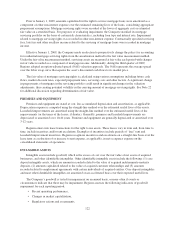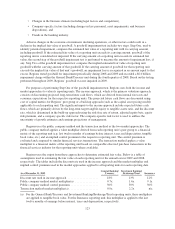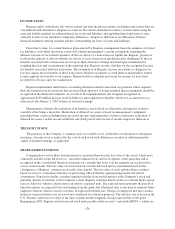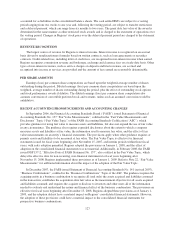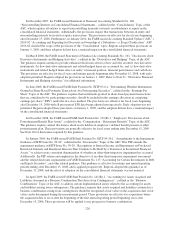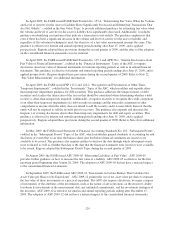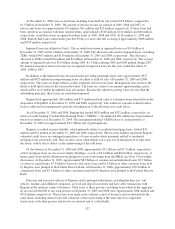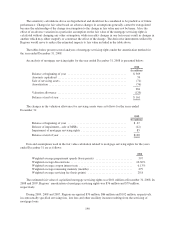Regions Bank 2009 Annual Report Download - page 144
Download and view the complete annual report
Please find page 144 of the 2009 Regions Bank annual report below. You can navigate through the pages in the report by either clicking on the pages listed below, or by using the keyword search tool below to find specific information within the annual report.FUTURE APPLICATION OF ACCOUNTING STANDARDS
In June 2009, the FASB issued Statement of Financial Accounting Standards No. 166, “Accounting for
Transfers of Financial Assets—an amendment of FASB Statement No. 140”, codified in the “Consolidation”
Topic of the ASC as ASU 2009-16, which eliminates the concept of a “Qualified Special Purpose Entity” from
FAS 140, changes the requirements for derecognizing financial assets, and requires additional disclosures. ASU
2009-16 is effective for fiscal years beginning after November 15, 2009. Regions is in the process of reviewing
the potential impact of these provisions; however, their adoption is not expected to have a material impact to the
consolidated financial statements.
In June 2009, the FASB issued Statement of Financial Accounting Standards No. 167, “Amendments to
FASB Interpretation No. 46(R)”, codified in the “Consolidation” Topic of the ASC as ASU 2009-17, which
modifies how a company determines when a VIE should be consolidated. It also requires a qualitative assessment
of an entity’s determination of the primary beneficiary of a VIE based on whether the entity (1) has the power to
direct the activities of a VIE that most significantly impact the entity’s economic performance, and (2) has the
obligation to absorb losses of the entity that could potentially be significant to the VIE or the right to receive
benefits from the entity that could potentially be significant to the VIE. An ongoing reassessment is also required
to determine whether a company is the primary beneficiary of a VIE as well as additional disclosures about a
company’s involvement in VIEs. ASU 2009-17 is effective for fiscal years beginning after November 15, 2009.
Regions is in the process of reviewing the potential impact of these provisions; however, their adoption is not
expected to have a material impact to the consolidated financial statements.
In January 2010, the FASB issued the ASU 2010-06, “Improving Disclosures about Fair Value
Measurements”, which requires additional disclosures related to the transfers in and out of fair value hierarchy
and the activity of Level 3 financial instruments. This ASU also provides clarification for the classification of
financial instruments and the discussion of inputs and valuation techniques. The new disclosures and clarification
are effective for interim and annual reporting periods after December 15, 2009, except for the disclosures related
to the activity of Level 3 financial instruments. Those disclosures are effective for periods after December 15,
2010 and for interim periods within those years. Regions is in the process of reviewing the potential impact of
ASU 2010-06; however, the adoption of this ASU is not expected to have a material impact to the consolidated
financial statements.
NOTE 2. VARIABLE INTEREST ENTITIES
Regions is involved in various entities that are considered to be VIEs, as defined by authoritative accounting
literature. Generally, a VIE is a corporation, partnership, trust or other legal structure that either does not have
equity investors with substantive voting rights or has equity investors that do not provide sufficient financial
resources for the entity to support its activities. The following discusses the VIE’s in which Regions has a
significant interest.
Regions owns the common stock of subsidiary business trusts, which have issued mandatorily redeemable
preferred capital securities (“trust preferred securities”) in the aggregate of approximately $1 billion at the time
of issuance. These trusts meet the definition of a VIE of which Regions is not the primary beneficiary; the trusts’
only assets are junior subordinated debentures issued by Regions, which were acquired by the trusts using the
proceeds from the issuance of the trust preferred securities and common stock. The junior subordinated
debentures are included in long-term borrowings and Regions’ equity interests in the business trusts are included
in other assets. Interest expense on the junior subordinated debentures is reported in interest expense on long-
term borrowings. For regulatory reporting and capital adequacy purposes, the Federal Reserve Board has
indicated that such trust preferred securities will continue to constitute Tier 1 Capital until further notice.
Regions periodically invests in various limited partnerships that sponsor affordable housing projects, which
are funded through a combination of debt and equity. These partnerships meet the definition of a VIE. Due to the
130




